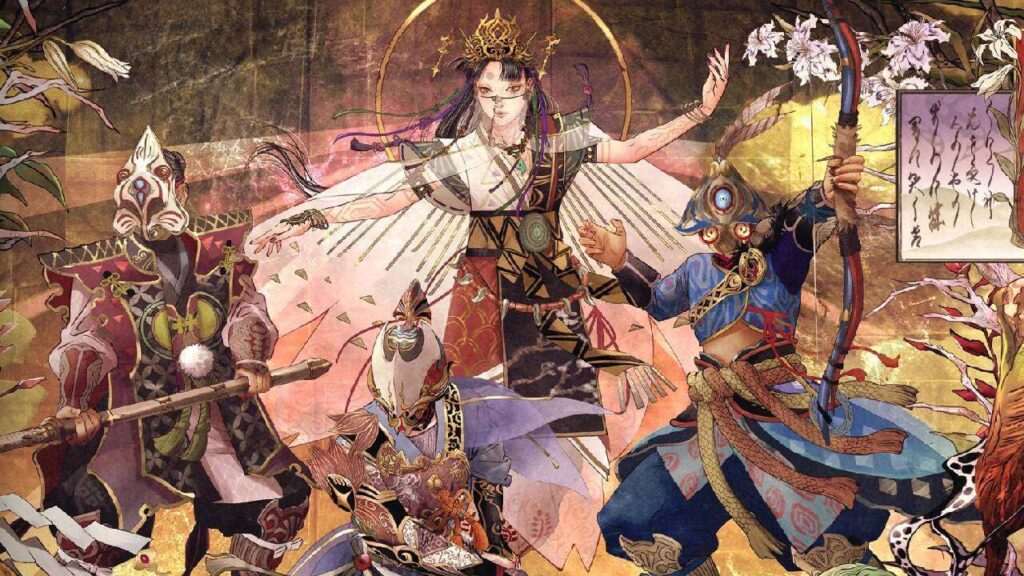At first glance, Kunitsujin: Path of the Goddess seems like a metaphor for spinning a plate. Each stage requires you to clear away supernatural decay, rescue villagers, set traps, and fight off waves of horrific demons, all with the goal of helping a holy maiden escape the plague of Mount Kafu. However, the gameplay mechanics required to achieve all of these tasks are bundled together to create one of the more unique experiences in video games this year.
At every turn, Kunijin God will test your fighting skills, intelligence, and reflexes to prevent the damsel in your care from rotting away. There are some elements where the fun of sword-wielding, demon-slaying action gives way to trivial tasks, but these minor issues aren’t enough to ruin the entire experience. Kunitsu-Gami is a refreshing addition to Capcom’s stable of IPs and reliably executes an engaging gameplay loop.
In this new adventure, you take control of Soh, a samurai sworn to protect the aforementioned holy girl Yoshiro. Their home, Mount Kafu, has been invaded by the Seethe, a demonic force of otherworldly entities that have spread a horrific plague of “filth” across the land. Soh must lead Yoshiro to every town and village in the mountain, protecting her at all costs so that she can clean up the filth once and for all.
The deep influence of Japanese culture on this game can be seen at a glance. The ceremonial costumes, traditional dances and music selections were immediately captivating and felt like we were playing Japanese folklore. Remarkably, the game achieves this despite having very little dialogue. Just the action of the characters on screen draws you in, which is pretty impressive.
That said, the narrative arc also takes a backseat to the central gameplay loop, which makes the overall story slightly less effective. Kunitsu-Gami is more concerned with making you work towards every victory than telling you a story before and after you achieve it. While this was disappointing, the effectiveness of the gameplay loop – and the multi-level feel it created – quickly overcame that disappointment.
Each new chapter begins with Yoshiro and Soh standing at one end of the stage, with a black path on the ground marking the way to the rotting torii gate, which when cleared, will restore the entire area. The day and night cycle offers two distinct yet intertwined game modes, each with its own challenges.
During the day, you’ll scout the area while rescuing villagers trapped in decay and clearing smaller, enclosed areas of filth. Clearing these areas earns you crystals – by purifying and cutting down the small plants that line the roads – which can be used both to carve a path through the decay, allowing Yoshiro to move on, or to assign jobs to the villagers you rescue. Once an area is cleared of all filth, the temple will open and you will be rewarded.
The simple act of starting a stage and completing the set stage creates a lot of stress-inducing decisions that you need to consider before you attack for the first time. Crystals are a limited resource, but are they better spent on villagers who serve as defenses, or on clearing a path for Yoshiro? Is there a compromise that would get Yoshiro to a place that’s easier to defend than her starting point? The strategy elements are fascinating, stressful, and exciting all at once, and the tension only intensifies as the day turns into night.
As night falls, Soh and his companions take on the Seethe tribe, the strategic element immediately giving way to a hack-and-slash operation. As more waves appear at night, their numbers increase, and without a solid strategy for handling these numbers, you can be overwhelmed. I was impressed by the sheer variety of Seethes in the game; it felt like every stage brought you some new formidable enemies, each with their own abilities and weaknesses. These minions also drop crystals for use in the next day cycle, so despite how scary these monsters are, you’re encouraged to fight every one of them. Thankfully, slashing these demons is a lot of fun, as waves of enemies from above the moon to below provide intense and constant action.
However, boiling can be silly at times, ruining the flow of the action every time it happens. For example, one type of Seethe is designed to keep distance and attack with projectiles. However, in order to maintain this distance, they corner themselves and stay in one place. Since wave after wave of boiling usually doesn’t start until the previous wave has been defeated, you can leave that lone demon alone for as long as you like, which will give you an unexpected respite, to some extent. It feels like cheating.
Kunitsu-Gami is a refreshing addition to Capcom’s stable of IPs and reliably executes an engaging gameplay loop
What’s most impressive about Kunitsujin’s core loop is how the nighttime battles instantly make the fruits of your day’s labor visible—or make you notice things you missed. You may have put up protective barriers to reinforce the path ahead of Yoshiro, but the left or right wing may be open. When multiple portals to Seethe open at a later stage, what you think might explain both paths may only affect one of them. If you make the wrong decision, most of the time you can adjust your formation on the fly or make a different plan for the next cycle, but sometimes a mistake can ruin the entire game and you have to make adjustments after the game – on the screen superior. That immediate reward, whether positive or negative, is always exciting and immediately makes you think about what comes next.
While what’s described above is the main format for each stage, some of them take completely different approaches, as if Capcom realizes that keeping the same day/night cycle over and over again might turn some players off. One of the stages has Soh, Yoshiro, and all the villagers taking a boat across a river that’s flooded with water from all sides. Another sees a unique demon that immediately possesses Yoshiro, which renders Soh unable to fight, so all you can do is assign jobs to villagers and guide them into becoming a little floating spirit. Forrest Gump’s old adage about chocolate somehow, incredibly, applies here too. You never know what you’re going to get when you start a new phase.
Most stages also have adjacent boss battles, which are unlocked after the main challenge is completed. These are the best parts of Kunitsujin, as each boss offers some of the best combat in the game this year. Some are just bigger, badder versions of the Seethe we’ve seen before, but some are completely unique monsters with an array of attacks that require deft dodging, well-timed parries, and careful attacks. Defeating them earns Sue and his companions a mask, which manifests itself in new jobs the villagers can take on – a fair reward for the intense combat you endure, which feeds back into adding new wrinkles to the core gameplay loop.
Outside of the core loop, there’s a base-building mechanic, but it’s much more mundane than anything else in the game. Soh can revisit areas that have been cleared by Yoshiro and instruct villagers to rebuild areas destroyed by Seethe. These missions are completed as you progress through the main story chapters, meaning you must return to receive the rewards these fixes provide.
On the surface, this sounds like an optional side mission, but there’s a catch: the main reward for completing these base-building missions is musubi, a material that serves as the primary upgrade resource for Soh and the villagers. This turns a boring but skippable side quest into a boring but very important mission, which bogs down the entire experience by forcing you to backtrack after each completed stage. Additionally, completing these fixes requires completing a certain number of missions, which includes replaying older missions, but repeating the same missions over and over only adds to the boredom.
Additionally, while the idea of rebuilding something that was destroyed isn’t an issue, its implementation is; in order to initiate those repairs, you have to run to specific points in the area, which slows things down even further. All of this can be managed in the menu, which will get you back in action faster than we can now.

gallery
The way Kunitsu-Gami instantly tugs at your mind in different ways throughout the day/night cycle is intense, but the excitement within it is indescribable. Capcom has cleverly blended two seemingly different game genres together, adding tower defense and even some RPG elements for flavor, creating an experience that succeeds rather than fails. Sure, there are some missteps – namely in the incredibly tedious base-building section – but the action and strategy offered in the core experience overcomes these tedium, creating a game worth your time.
Capcom has been firing on all cylinders lately with its long-running franchise, and now that success has manifested itself into an interesting new IP. Kunitsujin finds its footing right out of the gate, and we may just be witnessing the next great Capcom series blazing a trail right before our eyes.

